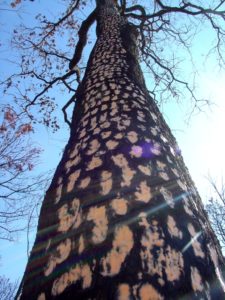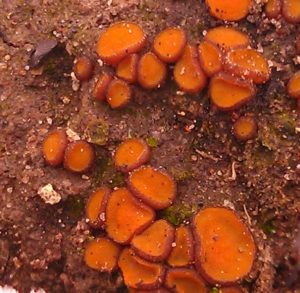 COMMON NAME: Fire Fungus
COMMON NAME: Fire Fungus
SCIENTIFIC NAME: Anthracobia melaloma
DISEASE DESCRIPTION
Although not a disease, this fungus caused a growth on trees killed in Bastrop, TX, during the devastating wildfire in 2011. Prior to being properly identified, the fungus was considered to be a public health menace.
SYMPTOMS
Initially appears in the areas most intensely impacted by recent wildfires as white/cream colored fungal growth on trees that eventually turns an orange color [1]. The fruiting bodies are orange cup or disk shaped structures (ascocarps) with small brown hairs around the edge. They typically grow on charred wood left behind by the fires including both debris and up the trunks of trees still standing [2]. The fungus has a short development cycle leading to rapid build-up in post fire conditions [3].
 BIOLOGY
BIOLOGY
Anthracobia melaloma is a cosmopolitan, pyrophillic species of ascomycete classified in the family Pyronemataceae [2]. Because the fungus is ubiquitously present airborne spores are often the first to reach fire devastated environments and thrive in the alkaline soil left behind often as the dominant species for several months following the disaster [4]. The characteristic orange fungal growth of A. meleloma was reported covering charred tree remains following the 2011 fires in Bastrop, Texas [1]. It is believed that this species is important in the initial stages of environmental recovery following these fires. The fungus’ mycelial network may combat erosion in the most damaged areas and it concentrates metabolites useful for the growth of other organisms arriving later in the recovery of the area [4].
MANAGEMENT METHODS
Management of A. melaloma is not necessary and would be difficult due to its ubiquitous world distribution. The alkaline soil left behind after a wildfire and lack of competition are conducive to rapid population expansions. However, its role in environmental recovery and preference for charred wood remains makes management less of a concern and is probably essential to recovery of the ecosystem.
RESOURCE LINKS:
- McBride, S., Richards, C., Appel, D., and J. Pase. 2012. Identification of a potential pyrophilous fungus following a forest fire in Bastrop, TX. Phytopathology 102:S4.78.
- Davis RM, Sommer R, Menge JA (2012). Field Guide to Mushrooms of Western North America. Berkeley, California: University of California Press. p. 388. ISBN 978-0-520-95360-4.
Provides description of fungal biology and appearance.
- Mysterud, I., Mysterud, I. & Bleken, E. 1997. Management of forest and range fires. In: Bleken, E., Mysterud, I. & Mysterud, I. (Eds.). Forest fire and environmental management: A technical report on forest fire as an ecological factor. Contracted Report. Directorate for Fire & Explosion Prevention and Department of Biology, University of Oslo, pp. 122-128.
Describes the impact of forest fire on fungi including A. melaloma
- Claridge, A. W., Trappe, J. M., and Hansen, K. 2009. Do fungi have a role as soil stabilizers and remediators after forest fire? Forest Ecology and Management 257:1063-1069.
Talks at length about A. melaloma in discussion of post fire fungi found at two different fire disasters in Washington state and one in Australia.
This factsheet is authored by Nick Farmer (PhD PLPM)
Factsheet information for the plant health issues represented by the images on the 2019 TPDDL calendar were written by graduate students enrolled in the Department of Plant Pathology & Microbiology PLPA601 Introductory Plant Pathology course in the 2018 Fall semester (course instructor: Dr. David Appel). This exercise provides an opportunity for a high impact learning activity where the students are tasked with producing an informational output directed to the general public and to provide opportunity for the students to write.